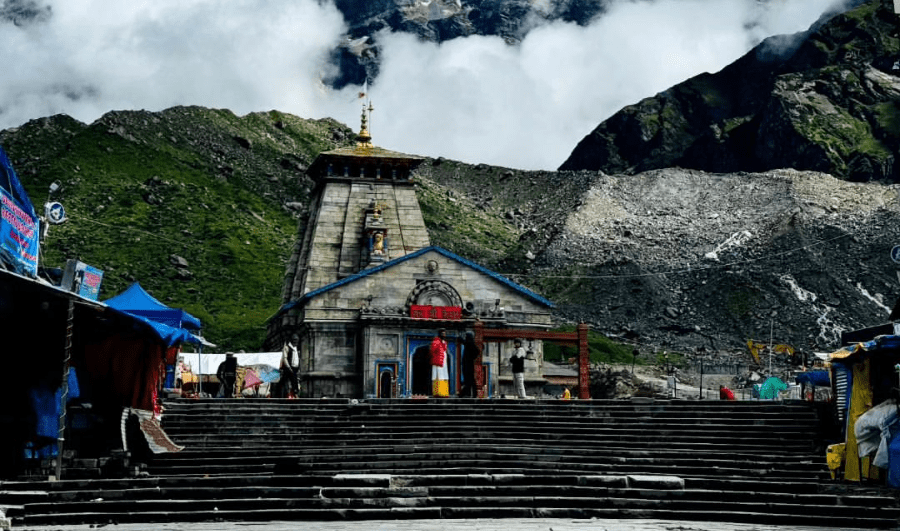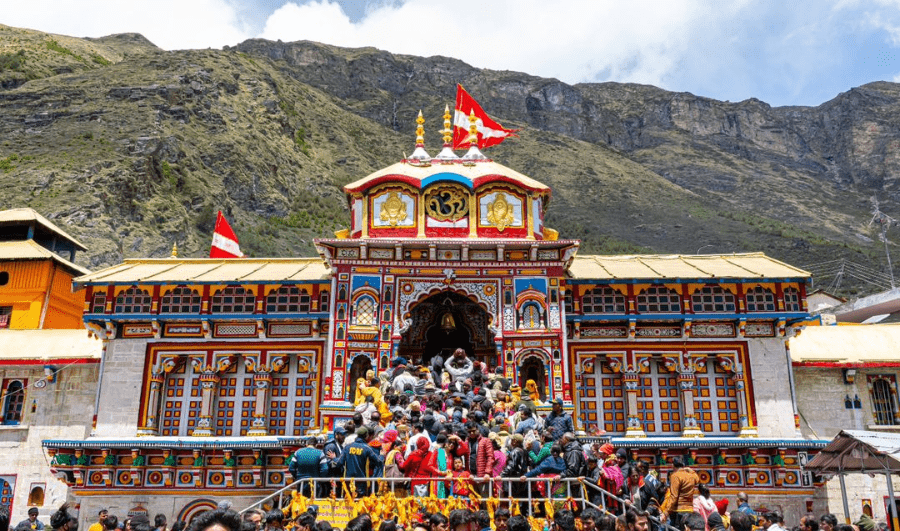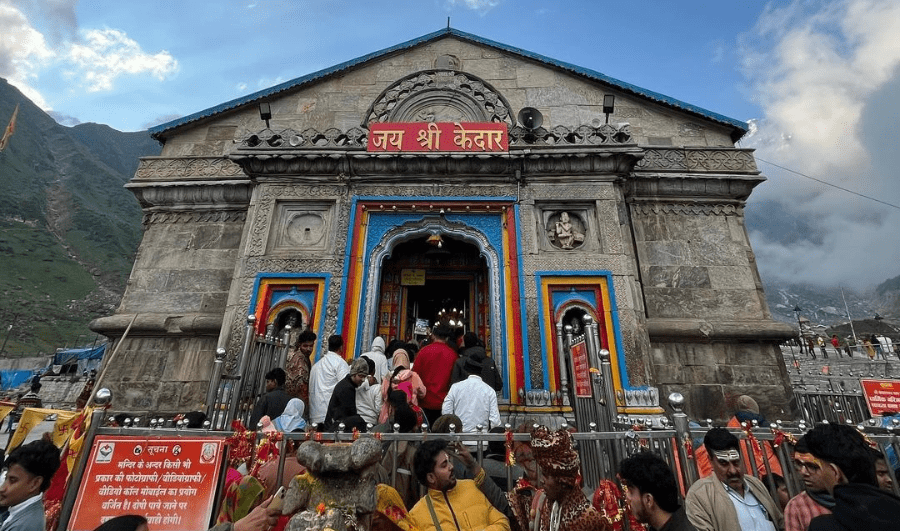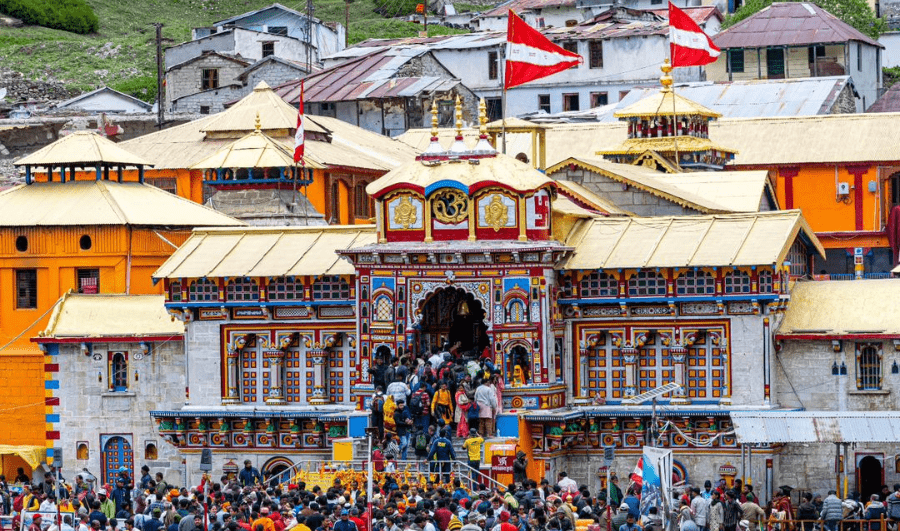Overview - Kedarnath and Badrinath Yatra
Kedarnath and Badrinath most well-known Char Dham Yatra pilgrimage site. Kedarnath is situated at 12,500 feet/ 3600 meters near the Chorabari Glacier, the source of the Mandakini River. It is surrounded by snow-capped mountain peaks. The Kedarnath Mountain is located near Kedarnath. Every year, thousands of pilgrims from around India come to visit Lord Shiva temple in Kedarnath.
The Badrinath Temple, also known as the Badrinarayan Temple, is one of the best Char Dhams in Uttarakhand and is located in the town of Badrinath. Badrinath is at an altitude of around 3,100 m/10,200 feet. This sacred village is situated in the Garhwal Himalayas, on the banks of the Alaknanda River, between the Nar and Narayana mountain ranges. It is believed that the temple was founded by a Vedic scholar and teacher Adi Shankaracharya in the 18th century. With Lord Vishnu as its presiding deity, the temple is only open for 6 months from mid-April to October end. Heavy snowfall makes it unreachable during the winter.
With our Kedarnath and Badrinath Yatra package, you will have the best travel experience. Our Kedarnath and Badrinath tour packages include picking and dropping from the location, hotel and food, and travel accommodation.
Best Time To visit Kedarnath and Badrinath
Kedarnath and Badrinath Yatra from April to June
During the summer, Badrinath and Kedarnath are heaven on Earth, with clear skies, calm days, and beautiful landscapes to explore. As in other seasons, you will have snow or rain, but summer makes this the greatest time to visit these holy places. Furthermore, you can share the spirituality of the temple, yatra, or pilgrimage.
In the summer, the sun comes out to bless the weather in Kedar and Badri. Although temperatures might drop as low as 5°C at night, summer weather is generally pleasant. Summer is the ideal time to visit Kedarnath and Badrinath and its surroundings. The sun warms the land sufficiently, which makes travel easy. Kedarnath and Badrinath's best time to visit is during this month.
Kedarnath and Badrinath Yatra from July to September
Cold and chilly days make up an important aspect of the monsoon weather at Badrinath and Kedarnath. The monsoon season may be great for visiting the area, with one exception being rain. Monsoon showers range from light to severe rainstorms, which may limit your ability to go out and explore.
July and August witness the most rain, with the droplets drying up substantially by September. The risk of landslides in this location is considerable during the monsoon season, hence tourists or pilgrims avoid visiting here during this time of year. So, keep an eye out for the weather report if you are planning to come here during the rainy season.
Kedarnath and Badrinath Yatra from September to November
While September and early October are mostly dry and snow-free, the first flakes of winter begin to fall in mid-October. By the end of October, Badrinath and Kedarnath temple is covered in a thick covering of snow.
Roads to the city are closed because of severe weather, as snow continues till March. November is the last month until you can visit the temple because the door closes during ‘Bhai Dooj’ and opens again in April. Due to heavy snowfall, the yatra remains closed until the weather and roads are clear.
How to Reach Kedarnath and Badrinath
First, you need to come to Haridwar to begin your journey. So, if you are planning for Kedarnath and Badrinath Yatra then you need to know the entire route and how you can smoothly plan your journey. All the major cities in India are connected through road, train, and air. You can take our Kedarnath and Badrinath tour packages for a seamless travel experience.
These are the best 3 ways to visit Kedarnath and Badrinath:
By Air
The main airport of Uttarakhand is Jolly Grant Airport located in Dehradun. Many prefer to arrive in Dehradun via flight as it saves time, although it is more expensive. Direct flights are available to Jolly Grant Airport. From there, you need to travel approximately 40 km to reach Haridwar. You can either book a cab or use local transportation like a bus to reach here.
By Train
If you prefer a more convenient and affordable means of travel, then trains are the best option. Express trains such as Nanda Devi Express, Kota Express, Shatabdi Express, Jan Shatabdi Express, and Vande Bharat Express offer direct routes to Haridwar from Delhi.
By Road
You can find a direct Volvo bus that drops you at Haridwar Bus Station, which is a more economical but longer option compared to flights. Alternatively, you can book a direct cab to reach Kedarnath and Badrinath.
With our Kedarnath and Badrinath Yatra Package, you will get all the accommodations including travel, food, and stay.
Kedarnath and Badrinath Yatra from Haridwar
The Kedarnath and Badrinath Yatra Package starts from Haridwar. However, for those planning to visit at their convenience, knowing the entire route is essential for a smooth travel experience. There are 2 main ways to travel:
Bus/ Jeep:
This is the most economical method. You can take a direct bus or jeep from Haridwar to Sonprayag. From Sonprayag, you'll need to use local transportation to reach Gaurikund, which costs around 40-50 rupees. Ensure to catch a morning bus on time as the travel time is approximately 8 hours.
To reach Badrinath, you'll need to return to Rudraprayag and then take a bus or jeep to Badrinath.
Cab:
Booking a direct cab from Haridwar to Kedarnath and Badrinath is more expensive but faster. The travel time is around 7-8 hours via cab.
Kedarnath and Badrinath Yatra Package Itinerary
Day 01: Haridwar– Guptkashi.
Altitude: 4,300 ft/ 1300 m
Distance: 200 km
Duration: 6-7 hours
Our day will start early and the destination is Guptkashi. The pickup location will be from Haridwar Bus stand and Railway Station. We'll stop for lunch along the way before moving to Guptkashi. Once we arrive, we will check into our pre-booked accommodation.
On the way to Guptkashi, you will get a beautiful view of the mountains. You can see the holy river Mandakini flowing along the road.
The evening is free for a visit to the Kashi Vishwanath Temple. You can go for a leisurely walk while admiring the stunning scenery. Enjoy an overnight stay at the hotel in Guptkashi. The journey will be full of breathtaking views so keep your cameras ready to capture every moment.
Day 02: Guptkashi to Sonprayag to Kedarnath.
Altitude: 12,500 ft/ 3600 m
Distance: 30 km drive to Sonprayag, 16 km trek to Kedarnath
Duration: 1-hour drive, 7-8 hour trek
The next day is the Kedarnath Temple darshan that you have been waiting for. Our journey will begin early in the morning from Guptkashi to Sonprayag. The distance is around 30 km. It will take 1 hour to reach Sonprayag. After that, we need to reach Gaurikund.
No private vehicle is allowed from Sonprayag so you have to take public transportation i.e. a taxi that will cost you 40-50 rupees per person to reach Gaurikund. The Kedarnath Trek begins from Gaurikund. It's a 16 km long trek that will take you 7-8 hours to complete.
Once you reach, spend some time and visit the Kedarnath Temple and the beauty surrounding the temple. We will have our meal and sleep for the night.
Day 03: Kedarnath –to Gaurikund by Trek to Sonprayag to Sari Village.
Altitude: 12,500 ft/ 3600 m to 6600 ft/ 2000 m
Distance: 16 km trek from Kedarnath to Gaurikund, 5 km drive to Sonprayag, 50 km drive to Sari Village
Duration: 7-8 hour trek, 1 hour drive to Sonprayag, 2-3 hours drive to Sari Village
The next day we will leave early after having our breakfast. We need to come back to Sonprayag from Kedarnath. First, we will trek down from Kedarnath to Gaurikund which will take 7-8 hours. After reaching Gaurikund we will drive back to Sonprayag and from there we will head towards Sari Village.
The total travel time will be around 4-5 hours to reach Sari Village from Sonprayag. Sari village is a beautiful village with a picturesque landscape located at an altitude of 6,600 feet/ 2,000 m. It is also the base camp for the Deoria tal. Chopta Trek is around 20 km away from Sari Gaon.
We will be spending our night at Sari Village and will leave for Badrinath the next day. Eat your dinner and rest for the night.
Day 04: Sari to Badrinath.
Altitude: 6,600 ft/ 2000 m to 10,200 ft/ 3100 m
Distance: 160 km
Duration: 6-7 hours drive
This is the day that you have been waiting for Badrinath Temple Darshan. We will begin our day early from Sari village after having breakfast. The journey will start from Sari Village to Badrinath which is around 160 km away and takes 6-7 hours. On the way to Badrinath, you will see the beautiful landscape that will fill your journey with joy.
Sari Village is located in the Rudraprayag area of Uttarakhand, surrounded by lush flora and breathtaking Himalayan peaks. After reaching Badrinath we will check in our hotel keeping the luggage in the room and will leave for the Temple darshan. Tapt Kund is a natural warm spring on the banks of the Alaknanda River, where bathing is traditional before entering the Badrinath temple.
Enjoy your time in the temple as we will be coming back to our hotel for an overnight stay in Badrinath. This is the last day of our 5-day trip as we will be leaving for Haridwar the next morning.
Day 05: Badrinath to Haridwar.
Altitude: 10,200 ft/ 3100m 1000 ft/ 640 m
Distance: 310 km
Duration: 8-9 hours
Our trip has come to an end. We will have our breakfast, check out of our hotel, and head back to Haridwar. We will be covering a distance of 310 km from Badrinath to Haridwar which will take us 8-9 hours. On the way, we will be stopping for lunch before starting our journey again. Enjoy the mesmerizing view and all the memories that you made here.
We will reach Haridwar by evening or night so if anyone has to travel to other cities make your necessary arrangements before reaching. The drop-off location will be Haridwar Railway station and bus stand. Kedarnath and Badrinath tour packages end when we reach Haridwar.
The best time to visit Kedarnath and Badrinath is from April to June and September to November. You will have pleasant weather during the summer. If you want less crowd then the ideal time would be October and November.
The nearest airport is Jolly Grant in Dehradun. You need to take public transport or book a private cab from Haridwar, Rishikesh, or Dehradun to reach Kedarnath and Badrinath.
No, the Kedarnath and Badrinath tour does not include a flight ticket. You must book your flight tickets. The Kedarnath and Badrinath tour packages will only cover your travel, meals, and hotel.
Definitely, you can visit both the temples alone. However, make sure you stay safe and careful throughout the trip and get proper information and knowledge about the places and routes before planning your trip. Also, carry essentials in case of an emergency.
Kedarnath is situated at a height of around 12,000 feet/ 3500 m whereas Badrinath is located at 10,000 feet/ 3000 m. Both these temples lie within the Garhwal Himalayan range.



